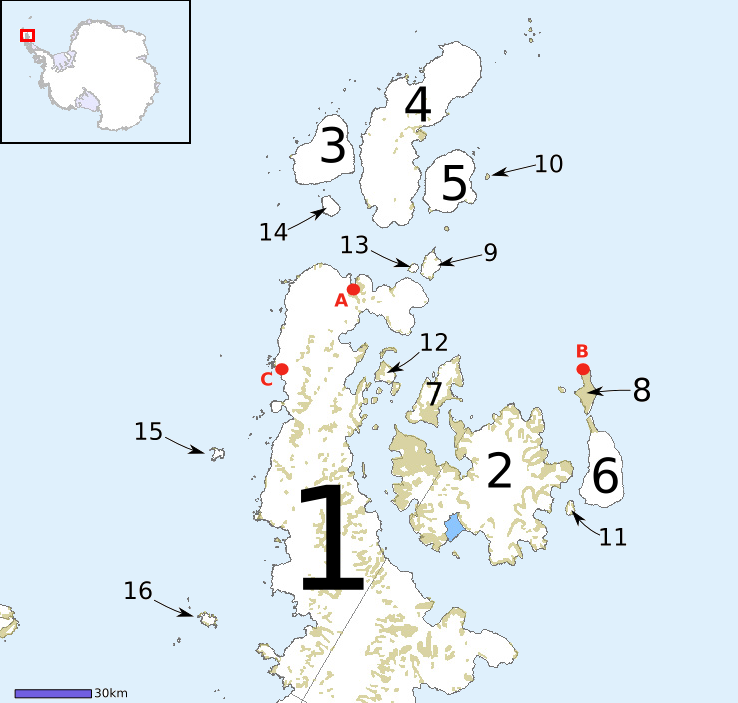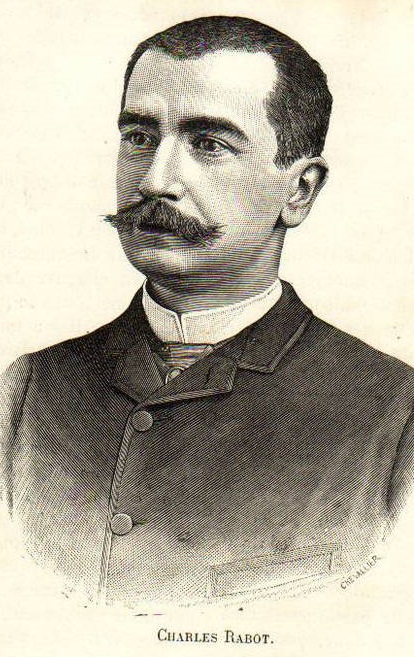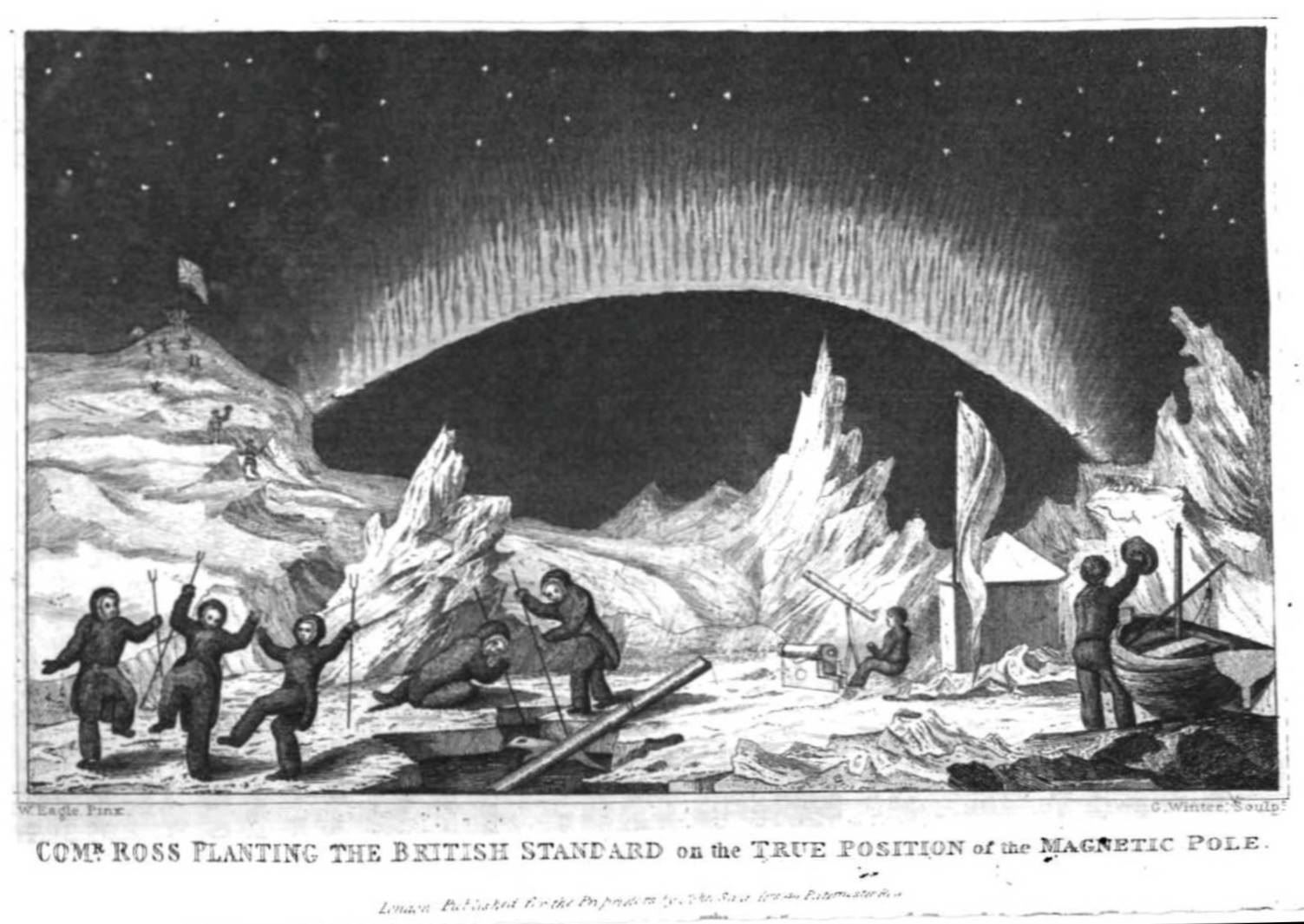|
Ekelöf Point
Markham Bay () is a bay wide, lying between Ekelöf Point and Hamilton Point on the east side of James Ross Island, Antarctica. Location Markham Bay indents the southeast shore of James Ross Island, which lies to the southwest of Trinity Peninsula, at the tip of the Antarctic Peninsula in Graham Land. It faces Snow Hill Island and Seymour Island to the southeast. It is below Mount Haddington to the northwest. Exploration and name Markham Bay was possibly first seen by a British expedition under James Clark Ross, who explored this area in 1842–43. It was first charted by the Swedish Antarctic Expedition (SwedAE), 1901–04, under Otto Nordenskjöld, who named it for Sir Clements Markham. Features Ekelöf Point . A high rocky point which lies southwest of Cape Gage and marks the north side of the entrance to Markham Bay. First seen and surveyed by the SwedAE under Otto Nordenskjöld, 1901-04, who named it Kap Ekelöf after Doctor Eric kelöf, medical officer of the expedit ... [...More Info...] [...Related Items...] OR: [Wikipedia] [Google] [Baidu] |
James Ross Island
James Ross Island () is a large island off the southeast side and near the northeastern extremity of the Antarctic Peninsula, from which it is separated by Prince Gustav Channel. Rising to , it is irregularly shaped and extends in a north–south direction. Location James Ross Island is separated from Trinity Peninsula, at the tip of the Antarctic Peninsula to the northwest, by the Prince Gustav Channel. Vega Island is to the north of the island, separated from James Ross Island by the Herbert Sound. Erebus and Terror Gulf is to the northeast. Seymour Island and Snow Hill Island are to the southeast. It is in the James Ross Island group. The island was connected to the Antarctic mainland by an ice shelf until 1995, when the ice shelf collapsed, making the Prince Gustav Channel passable for the first time. Mendel Polar Station, the first Czech Antarctic Base, is located on the island. Exploration and name James Ross Island was charted in October 1903 by the Swedish Antarct ... [...More Info...] [...Related Items...] OR: [Wikipedia] [Google] [Baidu] |
Otto Nordenskjöld
Nils Otto Gustaf Nordenskjöld (6 December 1869 – 2 June 1928) was a Swedish geologist, geographer, and polar explorer. Early life Nordenskjöld was born in Hässleby in Småland in eastern Sweden, in a family that included his maternal uncle, the polar explorer Adolf Erik Nordenskiöld, and cousin Gustaf Nordenskiöld. His father and mother were cousins, but his father's family name was "Nordenskjöld", while his mother's family name was spelled "Nordenskiöld". He studied at Uppsala University, obtaining a doctorate in geology in 1894, and later became a lecturer and then associate professor in the university's geology department. Career Otto Nordenskjöld led mineralogical expeditions to Patagonia in the 1890s, and to Alaska and the Klondike area in 1898. Antarctic Expedition Nordenskjöld led the 1901–1904 Swedish Antarctic Expedition. Their ship ''Antarctic'', commanded by the seasoned Antarctic sailor Carl Anton Larsen, visited Buenos Aires and the Falkla ... [...More Info...] [...Related Items...] OR: [Wikipedia] [Google] [Baidu] |
William H
William is a masculine given name of Germanic origin. It became popular in England after the Norman conquest in 1066,All Things William"Meaning & Origin of the Name"/ref> and remained so throughout the Middle Ages and into the modern era. It is sometimes abbreviated "Wm." Shortened familiar versions in English include Will or Wil, Wills, Willy, Willie, Bill, Billie, and Billy. A common Irish form is Liam. Scottish diminutives include Wull, Willie or Wullie (as in Oor Wullie). Female forms include Willa, Willemina, Wilma and Wilhelmina. Etymology William is related to the German given name ''Wilhelm''. Both ultimately descend from Proto-Germanic ''*Wiljahelmaz'', with a direct cognate also in the Old Norse name ''Vilhjalmr'' and a West Germanic borrowing into Medieval Latin ''Willelmus''. The Proto-Germanic name is a compound of *''wiljô'' "will, wish, desire" and *''helmaz'' "helm, helmet".Hanks, Hardcastle and Hodges, ''Oxford Dictionary of First Names'', Oxfor ... [...More Info...] [...Related Items...] OR: [Wikipedia] [Google] [Baidu] |
The Watchtower
''The Watchtower Announcing Jehovah's Kingdom'', or simply known as The Watchtower, is an illustrated religious magazine, published by the Watch Tower Bible and Tract Society of Pennsylvania. Jehovah's Witnesses distribute ''The Watchtower—Public Edition'', along with its companion magazine, '' Awake!''. The Watch Tower Society reports a circulation of 21.7 million per issue for ''The Watchtower—Public Edition'' in 444 languages, with one new issue produced annually. ''The Watchtower—Study Edition'', used at congregation meetings, is published monthly. History The magazine was started by Charles Taze Russell in July 1879 under the title ''Zion's Watch Tower and Herald of Christ's Presence''. According to its first issue, the magazine's original purpose was to draw attention to Russell's belief that people of the time were "living 'in the last days' 'the day of the Lord'—'the end' of the Gospel age," and that "the dawn of the 'new' age, are facts not only disc ... [...More Info...] [...Related Items...] OR: [Wikipedia] [Google] [Baidu] |
Charles Rabot
Charles Rabot (26 June 1856 in Nevers − 1 February 1944 in Martigné-Ferchaud) was a French geographer, glaciologist, traveler, journalist, lecturer, translation, translator, and explorer. He was also the first person to climb Kebnekaise, the tallest mountain in Sweden, which he accomplished in 1883. He led his first expedition to Spitsbergen in 1882 on the ship ''Petit Paris''. Ten years later, he embarked on a voyage on the ship ''La Mancha'', for a mapping mission, redrawing the map of the glacier Svartisen. He crossed Spitsbergen west to east and surveyed Prins Karls Forland. He was also a passionate ethnographer with the study of some Arctic and Volga peoples to the east and west of the Urals: Chuvash people, Cheremiss, Permiak, Zyrian, Khanty people, Khanty (Ostiaks) and Samoyedic peoples, Samoyeds. He published numerous articles on the above subjects, and also wrote and translated many books on Arctic exploration and sciences. The French base located at Ny-Ålesund bears ... [...More Info...] [...Related Items...] OR: [Wikipedia] [Google] [Baidu] |
Rita Of Cascia
Rita of Cascia, OSA (born Margherita Ferri Lotti; 1381 – 22 May 1457), was an Italian widow and Augustinian nun. After Rita's husband died, she joined a small community of nuns, who later became Augustinians, where she was known both for practicing mortification of the flesh and for the efficacy of her prayers. Various miracles are attributed to her intercession, and she is often portrayed with a bleeding wound on her forehead, which is understood to indicate a partial stigmata. Pope Leo XIII canonized Rita on 24 May 1900. Her feast day is celebrated on 22 May. At her canonization ceremony, she was bestowed the title of "Patroness of Impossible Causes". In many Catholic countries, Rita also came to be known as the patroness of abuse victims, couples and marriage difficulties, widows, and the sick. Her bodily remains lie in the Basilica of Santa Rita da Cascia. Early life Margherita Lotti was born in 1381 in the city of Roccaporena, a small hamlet near Cascia, Umb ... [...More Info...] [...Related Items...] OR: [Wikipedia] [Google] [Baidu] |
Falkland Islands Dependencies Survey
The Falkland Islands and Dependencies Aerial Survey Expedition (FIDASE) was an aerial survey of the Falkland Islands Dependencies The Falkland Islands Dependencies was the constitutional arrangement from 1843 until 1985 for administering the various British territories in List of Antarctic and sub-Antarctic islands, Sub-Antarctica and Antarctica which were governed from t ... and the Antarctic Peninsula which took place in the 1955–56 and 1956–57 southern summers. Funded by the Colonial Office and organized by Peter Mott, the survey was carried out by Hunting Aerosurveys Ltd. The expedition was based at Deception Island and utilized the ''Oluf Sven'', two Canso flying-boats, and several helicopters. The photographic collection, held by the British Antarctic Survey as the United Kingdom Antarctic Mapping Centre, comprises about 12,800 frames taken on 26,700 kilometers of ground track. References {{reflist British Antarctic Territory Surveying of the United Kingdom ... [...More Info...] [...Related Items...] OR: [Wikipedia] [Google] [Baidu] |
Sir Clements Markham
Sir Clements Robert Markham (20 July 1830 – 30 January 1916) was an English geographer, explorer and writer. He was secretary of the Royal Geographical Society (RGS) between 1863 and 1888, and later served as the Society's president for a further 12 years. In the latter capacity he was mainly responsible for organising the British National Antarctic Expedition of 1901–1904, and for launching the polar career of Robert Falcon Scott. Markham began his career as a Royal Navy cadet and midshipman, during which time he went to the Arctic with in one of the many searches for Franklin's lost expedition. Later, Markham served as a geographer to the India Office, and was responsible for the collection of cinchona plants from their native Peruvian forests, and their transplantation in India. By this means, the Indian government acquired a home source from which quinine could be extracted. Markham also served as geographer to Sir Robert Napier, 1st Baron Napier of Magdala, ... [...More Info...] [...Related Items...] OR: [Wikipedia] [Google] [Baidu] |
Swedish Antarctic Expedition
The Swedish Antarctic Expedition of 1901–1903 was a scientific expedition led by Otto Nordenskjöld and Carl Anton Larsen. It was the first Swedish endeavour to Antarctica in the Heroic Age of Antarctic Exploration. Background Otto Nordenskjöld, a Swedish geologist and geographer, organized and led a scientific expedition of the Antarctic Peninsula. The expedition's overall command was placed under the Norwegian Carl Anton Larsen, an experienced Antarctic explorer who served as captain of , and who had previously commanded a whaling reconnaissance mission in 1892–1893. Seven other scientists, including archaeologist Johan Gunnar Andersson, botanist Carl Skottsberg, and zoologist Axel Ohlin, along with 16 officers and men joined them on the voyage. On 16 October 1901, the ''Antarctic'' left the Port of Gothenburg. Events Despite its end and the great hardships endured, the expedition would be considered a scientific success, with the parties having explored mu ... [...More Info...] [...Related Items...] OR: [Wikipedia] [Google] [Baidu] |
Trinity Peninsula
Trinity Peninsula is the northernmost part of the Antarctic Peninsula. It extends northeastward for about 130 km (80 mi) to Cape Dubouzet from an imaginary line connecting Cape Kater on the north-west coast and Cape Longing on the south-east coast. Prime Head is the northernmost point of this peninsula. Some 20 kilometers southeast of Prime Head is Hope Bay, Antarctica, Hope Bay with the year-round Argentinian Esperanza Base. History It was first sighted on 30 January 1820 by Edward Bransfield, Master, Royal Navy, immediately after his charting of the newly discovered South Shetland Islands nearby. In the century following the peninsula's discovery, chartmakers used various names (Trinity Land, Palmer Land, and Land of Louis Philippe) for this portion of it, each name having some historical merit. The recommended name derives from "Trinity Land", given by Bransfield during 1820 in likely recognition of the Corporation of Trinity House, Britain's historical maritime pil ... [...More Info...] [...Related Items...] OR: [Wikipedia] [Google] [Baidu] |
James Clark Ross
Sir James Clark Ross (15 April 1800 – 3 April 1862) was a British Royal Navy officer and explorer of both the northern and southern polar regions. In the Arctic, he participated in two expeditions led by his uncle, Sir John Ross, John Ross, and in four led by Sir William Parry, William Edward Parry: in the Antarctic, he led Ross expedition, his own expedition from 1839 to 1843. Biography Early life Ross was born in London, the son of George Ross and nephew of Sir John Ross, John Ross, under whom he entered the Royal Navy on 5 April 1812. Ross was an active participant in the Napoleonic Wars, being present at an action where HMS Briseis (1808), HMS ''Briseis'', commanded by his uncle, captured ''Le Petit Poucet'' (a French privateer) on 9 October 1812. Ross then served successively with his uncle on HMS Acteon (1805), HMS ''Actaeon'' and HMS Driver (1840), HMS ''Driver''. Arctic exploration Ross participated in John's unsuccessful first Arctic voyage in search o ... [...More Info...] [...Related Items...] OR: [Wikipedia] [Google] [Baidu] |
Mount Haddington
Mount Haddington is a massive high shield volcano comprising much of James Ross Island in Graham Land, Antarctica. It is wide and has had numerous subglacial eruptions throughout its history, forming many tuyas. Some of its single eruptions were bigger in volume than a whole normal-sized volcano. Old eruption shorelines are widespread on the volcano's deeply eroded flanks. Haddington formed along the Larsen Rift dominantly during the Miocene and Pliocene epochs but more recent eruptions have produced tuff cones on its slopes. The youngest tuff cones and pyroclastic cones on the eastern slope are situated below the summit icecap and may have formed in the last few thousand years. Effusive eruptions have created large deltas composed of hyaloclastite breccia and lava flows. Mount Haddington was discovered on December 31, 1842 by the Ross expedition, a voyage of scientific exploration of the Antarctic from 1839 to 1843 led by James Clark Ross. Ross named the mountain after the ... [...More Info...] [...Related Items...] OR: [Wikipedia] [Google] [Baidu] |





